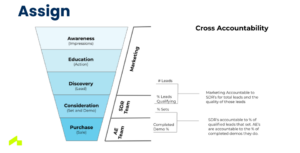3 Internal Steps Your Organization Needs to Take to Strengthen Your Marketing ROI
Many executives believe that marketing is a coin-operated vending machine: You stick a quarter in, and you get a snack back. They think that revenue will be amazing, easy to create, and simple to obtain.
The reality is that many different dials need to work in unison for your “marketing machine” to help your organization pursue its growth and brand goals. When you use these marketing initiatives in clear alignment with your organizational goals, products, and industry, marketing can be your biggest driver of growth. If not aligned to be a well-oiled machine, marketing can become a siloed department not clearly impacting the bottom line. To get exactly what you want from your marketing program, you need to understand which marketing options to choose and how to align the organization to your choices.
In this article, we’ll discuss three internal steps you need to take to ensure you are getting the most out of your marketing efforts as you make these channel and initiative choices. This will include defining what marketing means to your organization, aligning your marketing goals with the appropriate metrics, and assigning responsibility and accountability for certain marketing tasks and goals. Let’s dive in!
DEFINE What Marketing Means to Your Organization
Many organizations never take the first step of defining what marketing is supposed to do for their company. This seems like a simple step, but in my consulting experience, I have never had a client with a definition for success for their marketing team. Not one! They often think more broadly about the overarching goals of the organization without carefully defining what marketing’s role is for the company to impact those goals.
It is important to define the role of the marketing department within the business, especially when dealing with a marketing team with a variety of expertise. For example, marketing may be defined one way by your SEO manager and yet defined very differently by your graphic designer. With so many channels and different team members, declining to define what marketing means to the organization can leave your process in disorder.
To define marketing for the company, you will need to do the following:
- Select a definition closely tied to the company’s vision, mission, and values
- Align this definition with top-down organizational goals
- Ensure there is cross-functional alignment on the definition between teams and departments
This can be as simple as an OKR (objectives and key results) model, e.g., “We are going to do this by this date as measured by this.” It can even be aspirational: “Marketing is going to become the primary source of revenue in the organization and is measured by XYZ.” It can be a visionary or mission-based statement so your team is marching toward a future horizon point.
One assumption companies make is that marketing and sales teams are working perfectly together to reach one desired goal. Unfortunately, this isn’t always true. They are often speaking completely different languages or working toward separate goals. Before you can identify which dials you want to implement on your marketing machine and how that will work in unison with your sales plan, you need to begin with what marketing should look like for your organization.
This first step greatly reduces the chaos and disjointed approach marketing efforts can take within an organization.
ALIGN Your Marketing Plan with Appropriate Metrics
After you define what marketing means to your organization, you need to next align that definition with the appropriate metrics on an organization, team, and individual level. What we often discover is that success is defined differently across different stakeholders, different departments, and different expertise. It’s important to first understand your sales funnel and then identify the metrics that matter to the individuals and teams that are responsible for each part of that funnel. Let’s discuss how you can achieve that alignment.
Understand Your Sales Funnel
Before you can understand how marketing can help you achieve your goals, you need to understand your sales funnel. A sales funnel visually represents your customers’ journey from awareness to purchase. It is a framework to help you understand how to optimize your sales and marketing processes. A typical sales funnel may include several stages, including awareness, education, discovery, consideration, and purchase.
Each organization’s sales funnel may look slightly different, so understanding your nuanced sales funnel is very important. If you haven’t yet defined your funnel, start there. It doesn’t need to be complicated—however, you do need to understand how your customers move down the funnel to purchase your product or service. For a small organization, this could be as simple as “The person in marketing got a lead and passed it to the sales account manager.” For a larger organization, you may have additional hand-offs between more people and need more parts to your funnel.

The marketing team, unless it owns the entire funnel, typically influences the top three parts of the funnel: awareness, education, and discovery. Again, these metrics and their definitions will depend upon your goals, but they typically look like this:
- Awareness most often refers to the number of impressions you receive on your marketing materials.
- Education indicates that the customer has taken an action (e.g., downloaded a PDF, watched a video, etc.).
- Discovery indicates that the customer is ready to speak with a sales team member.
As we discuss below, the Consideration and Purchase stages are typically handled by the sales team or account managers for B2B organizations; however, in smaller organizations, the entire funnel may be owned by one individual or the entire marketing team. Understanding who is responsible for what is important to align goals with company objectives.
Align Marketing Goals to the Company’s High-Level Objectives
Now that we understand where the marketing team fits in terms of the sales funnel, we can align their goals with the company’s objectives. Marketing goals do not have to refer to revenue. In fact, marketing is typically not defined by revenue. Rather, as discussed above, it usually focuses on awareness, improving the customer experience, entering a new market, or generating leads. But it is best if it can be directly associated with the bottom line numbers.
As you begin to dig into your marketing definition and the objectives you want to achieve, you may discover there is misalignment. Your CMO, whether full-time or a fractional CMO, can help define these goals for you.
In summary, to align marketing, you need to do the following:
- Align your marketing goals and processes with the company’s high-level objectives.
- Align those same goals and processes to the sales funnel.
- Make sure marketing is aligned with tasks or areas marketing can actually own (e.g., revenue is usually not something marketing has control over).
ASSIGN Responsibility for Marketing Tasks and Goals
After you define what marketing means to your organization and align your marketing goals with key, appropriate metrics, then you need to assign accountability to the appropriate areas of the funnel.
Without an understanding of the responsibility of each of your team members and the interdependency of other’s responsibilities, your team’s direction can be misaligned. Marketing can mean something different to each stakeholder. For example, while working at another organization, I once threw a summer party, helped on the side for an acquisition, hosted a large digital event, and spoke at an event, all in the space of one week. I was all over the place in terms of my direction because I didn’t understand what I was accountable for and what to say no to. Before engaging in marketing, it’s important to identify each team member’s responsibilities and how they will be measured.
This begins by opening the lines of communication between teams and defining which part of the sales funnel each member is accountable for. In this example, one company I worked for first visualized the sales funnel and then defined which part of the sales funnel each team was accountable for. This helped our processes move more seamlessly and ensured everyone was responsible for helping us achieve the final goal of revenue through sales.

Marketing Team’s Typical Responsibility within the Sales Cycle
While your sales cycle may vary from this example, it is helpful to understand what marketing can be responsible for, where there is overlap, and who owns the other portions of your funnel. This often includes the following stages, which are similar to those we covered in the alignment process:
- Awareness, which is typically defined by impressions.
- Education, which is often identified by the actions they take.
- Discovery, which is the stage in which they are defined as a lead.
In this example, the marketing team is responsible for generating leads but is ultimately accountable to sales development representatives (SDRs) for the quality of those leads. We define this as cross-accountability. Not only does marketing have a responsibility to generate leads, but it is also accountable to another department to help move customers down the sales funnel. This creates great partnerships between groups so that no group works in a silo. In this example, defining the percentage of total leads they need to qualify adds another layer of accountability that supports their partners across the organization and gives the marketing team a great KPI for cross-functional success.
In this example, the SDRs were responsible for the next part of the funnel: the consideration stage, which this organization defined as demos and sets of demos. In this case, the sales team was responsible for setting a certain number of demos from the qualified leads. As part of this team’s cross-functional accountability, it was responsible for sending those customers who had completed the full set of demos to the account executives (AEs).
Finally, in this example, the AEs were responsible for those who finally purchased the product. They were also accountable to the organization to onboard and manage those accounts moving forward.
- Understanding who is responsible for which part of the sales funnel and what other teams they are accountable to ensures customers continue to move through the sales funnel. To make these assignments, you will need to do the following:
- Open the lines of communication between teams and discuss who handles what and to whom they are accountable.
Assign KPIs to each part of the funnel: number of leads, percentage of qualified leads, number of demos, percentage of completed demo sets, etc. It is important here to measure not only lagging indicators but also those KPIs that help you measure success. - When there are hiccups in the sales funnel, remember not to point fingers. Rather, expend that energy on identifying weaknesses in the process. That could be a need for more training, stronger marketing resources, a better definition of an SQL (sales qualified lead), and so on. Discuss this with team members so you can make effective changes in your process.
The goal is to build responsibility and accountability so everyone is working together.
In summary, in order to better ensure marketing ROI, you need to first define what marketing means for your organization. Then, you need to align your metrics to that definition and to the part of the funnel or customer journey in order to create impact. Finally, you need to assign cross-accountability to ensure great collaboration between teams. When marketing and sales are aligned, it all works! Having these frameworks in place ensures you can achieve a stronger marketing ROI and that the team is functioning well together.
Speak with One of Our Amazing Fractional CMOs
Effective CEOs strategically assemble top-notch teams to bring about remarkable results. By opting for an Amplēo fractional CMO, you eliminate ambiguity, enhance accountability and transparency, and implement a targeted marketing strategy to propel your ambitious revenue objectives. Instead of investing significant time and resources in searching for a full-time resource—which can be time-consuming and costly with potential missteps—consider engaging a CMO with decades of experience on a part-time basis. Contact us to speak to a CMO today!
